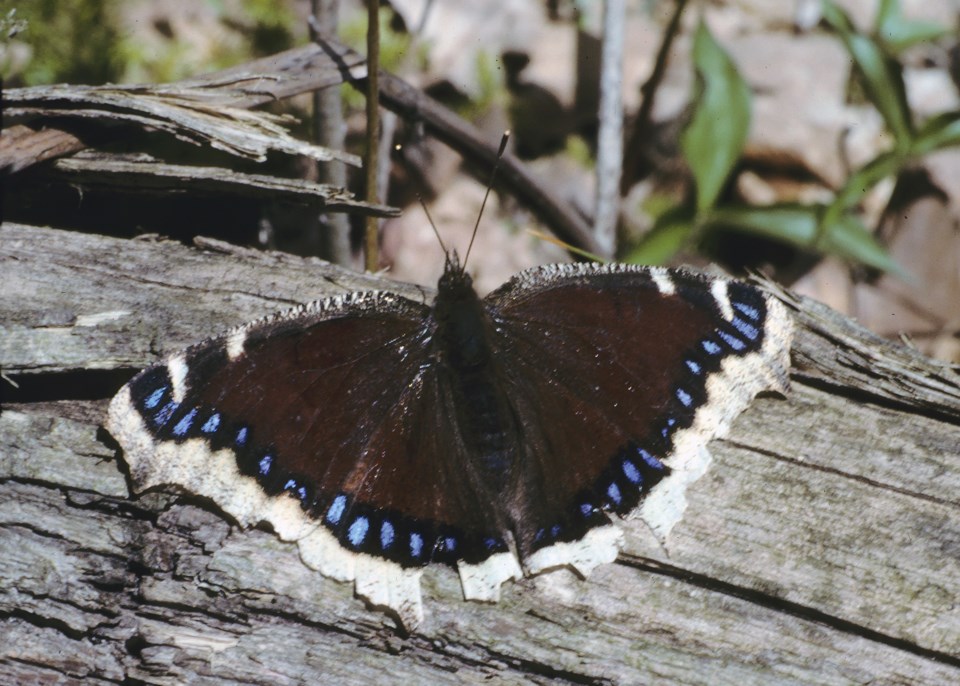The country lane looked peaceful enough, the first true warming rays of springtime sun easily splashing down on the still damp gravel.
The snow had gone, with a few small puddles of melt water all that remained to remember the winter snows.
As I wandered along, little did I know that this was a scene of great anxiety, as I had just intruded on the butterfly wars.
Some butterflies go away for the winter (the most well-known being the monarch) and some butterflies die in autumn, leaving eggs to survive the hardness of winter (that would be your tent caterpillar moth), and a few hide inside a chrysalis, caught in that nether world between teenage caterpillar and adult butterfly (an example being the yellow tiger swallowtail).
And there are those who beat the odds of surviving the dreaded winter by sleeping it away, perhaps better described as hibernating adults.
By already being capable of flight come an early spring day, these species of butterflies certainly have an edge over the late-comers and late-bloomers. A drip of sap to lap up and they're rarin' to go.
The advantage of mating and laying eggs so early in the year is that by the time the little caterpillars hatch out, the first leaves on their host plant are just budding open ... tender, succulent, nourishing.
Mom and Dad butterfly will have died by the time these new youngsters go through the life cycle, and by autumn these new adults will be ready to hibernate for the next coming winter.
So there was I, simply enjoying a stroll along a wooded lane, when I was suddenly attacked.
A butterfly of dark colouration and fairly huge proportion came winging in directly at my face! I flinched and ducked my head. A near miss!
Spinning around, I scanned the open air space for others, or maybe this one on a return run? Quietness.
Hmm, that was odd, I thought, and took another step to carry me on my way. As I took that step another butterfly rose up from the forest floor and circled tightly as it rose.
A flash of colour indicated that this was not the same one that gave me my original strafe. And then another rose up from the dried white leaves and intercepted the first.
There was a clashing of wings (at least I'm pretty sure they clashed, they were awfully close together) and a royal chase was held as they went up and down the lane, this lasting a full four seconds before vanquished was separated from victor.
What I had stumbled upon was the woodland border between the dark-coloured mourning cloak and the somewhat brighter coloured gray comma. These are two of the hibernating species, and this glorious spring day had instigated a civil war in the woodlot.
Every time a new butterfly appeared, only recently awakened from its own slumber, it was immediately challenged by the resident of its kind.
At first it looked like the mourning cloaks chased the mourning cloaks, and the gray commas took after their own, but I noticed that occasionally a comma would put the chase on a mourning cloak, and vice versa.
Obviously nobody was safe. All were considered a threat to the health, wealth and safety of the staked territory, my face included.
When I stood still, doing a reasonable impression of a dead poplar, the butterflies settled as well.
But it was obvious that each had its preferred look-out station, the mourning cloak on a sun-bleached stone and a nearby comma on a dead birch twig beside the puddle. Watching. Waiting. Scanning. Defending.
But defending what? No females were seen (not that I'm real good at telling the boy butterflies from the girl butterflies anyway), and the leaves of any food plants were still a week or more away from breaking open.
So what's with all the aggression? I guess it's just 'boys being boys' with the springtime influence.
Mourning cloaks are named for their amazing resemblance to a Victorian dark cloak or shawl that a widow had to wear for a year after the passing of her husband.
By tradition, a human could, after a year of mourning, embellish her cloak with a purple trim or some such somber decoration, thus letting prospective bachelors know she would soon be in the market for another partner.
The gray comma belongs to a group of butterflies that can be told apart by a small silver-coloured mark on the underside of their hind wing... this mark being shaped like a question mark, or a comma. Pretty straightforward identification procedure, eh what?
But the summer-born adults have a slightly different pattern to their upper wings than the autumn-born, which means that springtime Lepidopterists (those who have a penchant for butterflies) have to remember that the April plumage is really the last October plumage.
A good field guide helps, a lot. Try the Royal Ontario Museum's Butterflies of Ontario.
So as you traipse through a springtime woods, regaling in the warmth of sun, beautiful sun, remember that you may be intruding on a battlefield.
Keep your eyes peeled and your wits about you! Those butterflies could be anywhere.



